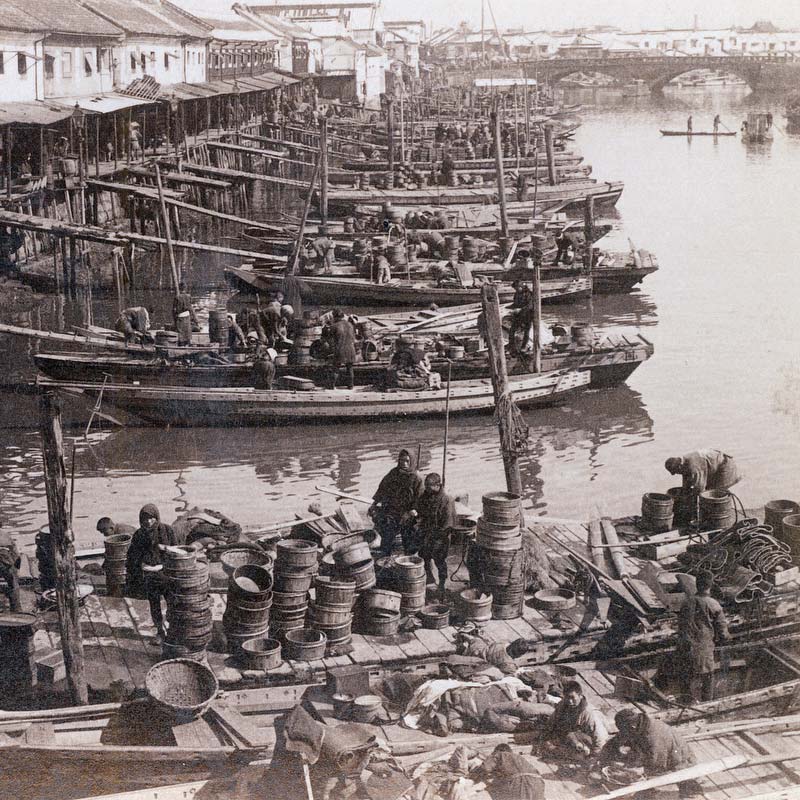The area between Isezakicho and Nigiwai-cho was known among foreigners as Theater Street.
Since around 1877 (Meiji 10), the street was filled with theaters, teahouses and restaurants which attracted lots of crowds and made this one of Yokohama’s most lively areas of the middle of the Meiji Period (1868-1912).
This photograph shows the area around Isami-za theater (勇座) in Matsugae-cho (松ヶ枝町, current Isezaki-cho 2-chome) as it looked sometime between 1887 (Meiji 20) and 1897 (Meiji 30). In 1899 (Meiji 32), the area burned down and all this vanished forever.
When you see all these flags advertising the theaters, productions and certain artists you understand Japan’s current love affair with neon signs. They are really electrified flags. I think that I prefer the flags, I just love how they move in the wind and the sounds they make.
They are a whole lot better for the environment, too.
For more information about Isezaki-cho and to see a photo of the same area during the 1910s, read Yokohama 1910s • Isezaki-cho 2-chome.
Published
Updated
Reader Supported
Old Photos of Japan aims to be your personal museum for Japan's visual heritage and to bring the experiences of everyday life in old Japan to you.
To enhance our understanding of Japanese culture and society I track down, acquire, archive, and research images of everyday life, and give them context.
I share what I have found for free on this site, without ads or selling your data.
Your support helps me to continue doing so, and ensures that this exceptional visual heritage will not be lost and forgotten.
Thank you,
Kjeld Duits
Reference for Citations
Duits, Kjeld (). Yokohama 1890s: Isezaki-cho 2-chome, OLD PHOTOS of JAPAN. Retrieved on December 14, 2025 (GMT) from https://www.oldphotosjapan.com/photos/252/isezakicho




Tornadoes28
How come these photos are in color?
#000271 ·
Kjeld Duits (Author)
Japan secretly invented color film long before the West. No just kidding! Photographers in Japan hired artists to color their photographs. Many of these artists used to work as woodblock colorists so they were very well-skilled. They also used special water colors that allowed the photo to shine through. At the time, this work was very highly regarded in the West and even received several awards. It is really beautiful, isn’t it?
#000272 ·
Tornadoes28
The coloring is very well done.
#000273 ·
Kjeld Duits (Author)
And this is how it looks over a hundred years after the coloring was actually done. The chemicals of the pigments, paper, air and humidity have had the freedom to interact for more than a century and this usually doesn’t make the photo look any better. When the images were still fresh, the coloring was exquisitely soft and gentle. I recently was able to acquire some images that for some reason were in much better condition than any of the other images in my collection and I was flabbergasted. It is lifelike and almost fragile in a way, and oh so beautiful.
#000274 ·
Kjeld Duits (Author)
For more detailed information about albumen photos and their coloring I can recommend the following articles:
• NINETEENTH CENTURY JAPANESE PHOTOGRAPHY: TECHNIQUES, CONSERVATION AND RESTORATION (by Annabelle SIMON, Photograph Restorer)
• SCIENCE OF ALBUMEN & ALBUMEN PRINTS (Stanford University)
#000275 ·